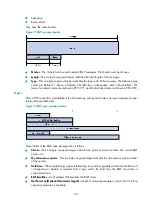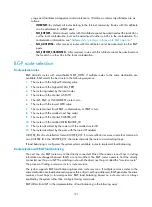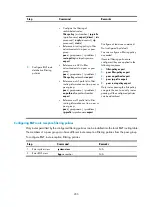
197
session. If neither party has the GR capability, the session established between them will not be GR
capable.
3.
When a Master/Slave switchover occurs on the GR Restarter, sessions on it will go down. Then,
GR-capable peers will mark all routes associated with the GR Restarter as stale. However, during
the configured GR Time, they still use these routes for packet forwarding.
4.
After the restart is completed, the GR Restarter will reestablish GR sessions with its peers and send
a new GR message, notifying the completion of restart. Routing information is exchanged between
them for the GR Restarter to create a new routing table and forwarding table and have stale
routing information removed. Then the BGP routing convergence is complete.
MP-BGP
Overview
BGP-4 supports IPv4 unicasts, but does not support other network layer protocols, such as IPv6.
To support more network layer protocols, IETF extended BGP-4 by introducing Multiprotocol Extensions
for BGP-4 (MP-BGP) in RFC 4760.
Routers supporting MP-BGP can communicate with routers not supporting MP-BGP.
MP-BGP extended attributes
In BGP-4, the attributes for IPv4 address format are NLRI, NEXT_HOP and AGGREGATOR
(AGGREGATOR contains the IP address of the speaker generating the summary route). They are all
carried in updates.
To support multiple network layer protocols, BGP-4 puts information about network layer into NLRI and
NEXT_HOP. MP-BGP introduces the following path attributes:
•
MP_REACH_NLRI
—Multiprotocol Reachable NLRI, for advertising feasible routes and next hops
•
MP_UNREACH_NLRI
—Multiprotocol Unreachable NLRI, for withdrawing unfeasible routes
These path attributes are both optional non-transitive, so BGP speakers not supporting multiprotocol
ignore these attributes and do not forward them to its peers.
Address family
MP-BGP uses address families to differentiate network layer protocols. For address family values, see RFC
1700,
Assigned Numbers
. The system supports multiple MP-BGP extensions, including IPv6 extension
(see "
."). Different extensions are configured in respective address family view.
NOTE:
This chapter provides no detailed commands related to any specific extension application in MP-BGP
address family view.
Protocols and standards
•
RFC 1771,
A Border Gateway Protocol 4 (BGP-4)
•
RFC 2858,
Multiprotocol Extensions for BGP-4
•
RFC 3392,
Capabilities Advertisement with BGP-4
•
RFC 2918,
Route Refresh Capability for BGP-4
•
RFC 2439,
BGP Route Flap Damping
















































